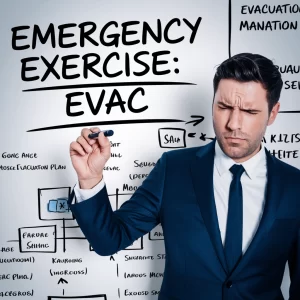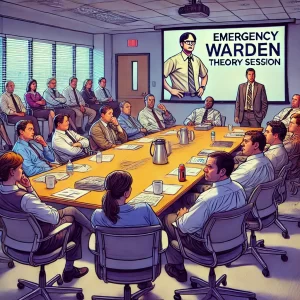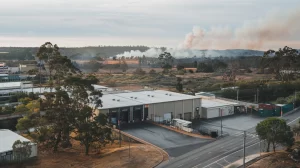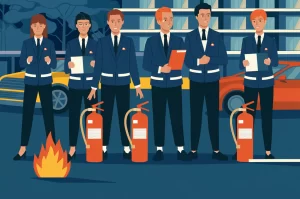This past weekend, the NSW Rural Fire Service (RFS) reminded Sydney residents that preparation for the upcoming fire season is crucial. During the “Get Ready Weekend,” communities were urged to meet with local firefighters to discuss fire readiness. It was a timely reminder, as the forecast suggests this fire season may be especially severe, particularly for those living in and around Sydney.
The urgent need for preparation became painfully clear when the NSW RFS issued an emergency warning on Saturday. The warning targeted Sydney’s Northern Beaches, as a massive bushfire swept towards Cromer Heights, threatening homes and communities. The fire was so intense that local authorities declared it “too late to leave,” urging residents in the danger zones to shelter in place as the fire approached. This fire was a warning for Sydney residents to prepare themselves against future bushfire threats.
Emergency Fire Sydney: The Immediate Threat to Northern Beaches
The emergency warning read as follows:
“EMERGENCY WARNING: Meatworks Fire, Northern Beaches LGA. The fire continues to burn in the vicinity of Cromer Heights. Those near Pinduro Place, Jersey Place, Maybrook Avenue, Kirrang Street, and Lady Penryhn Drive are at risk. Seek shelter now as it is too late to leave. Ember attacks are expected in Narraweena and Cromer, with embers blown long distances ahead of the main fire front, potentially starting new fires.”
This was the second significant fire emergency in the Sydney region within recent weeks. Late last month, another large fire ravaged parts of Horningsea Park, threatening homes and businesses alike. With these fires becoming more frequent, Sydney’s firefighting and emergency services are preparing for what could be a challenging fire season.
The Importance of Fire Preparedness for Childcare Providers
While fire safety is paramount for everyone in the Sydney region, it becomes even more critical for childcare providers, where the safety of young children is at stake. Emertrix, an emergency management consulting firm, is urging all childcare centres across Sydney to take immediate action. Here’s what we recommend:
-
Emergency Risk Assessment: Centres should thoroughly assess their location relative to nearby bushland. Even centres far from direct fire risks can be heavily impacted by embers, which can travel kilometres ahead of the firefront. This assessment should account for both the risk of flames and embers.
-
Impact of Smoke: If bushland is a distance away, the impact of smoke should not be underestimated. Poor air quality from smoke can affect children, staff, and the surrounding environment. It’s crucial to understand how smoke might infiltrate the centre and what measures can mitigate its effects.
-
Review Emergency Procedures: Every childcare facility should have comprehensive procedures in place for a range of potential scenarios. The question remains: are those procedures effective in a bushfire emergency? Centres need to consider their action triggers — such as when to evacuate, shelter in place, or take other protective measures.
-
Monitoring Bushfire Risks: Childcare providers must have a process in place to monitor fire threats, especially during weekends when the facility is closed. Fires don’t respect calendars or office hours, so the ability to stay updated is crucial.
-
Fire Prevention Equipment: Another consideration is the presence of fire-prevention equipment. Does the centre have fire extinguishers, hoses, or other tools that could provide some level of protection before firefighters arrive?
-
Parent Communication Plans: If a fire emergency forces a centre to close or relocate children, how will parents be informed? It’s essential to have a communication plan that reaches parents quickly and clearly. Partnering with nearby centres may provide temporary solutions, but this too requires pre-planning.
These considerations extend far beyond bushfire scenarios. Sydney’s Northern Beaches, for example, are also prone to severe storms, and childcare providers must take this into account when updating emergency plans.
Why Every Sydney Resident Should Be Concerned
Bushfires have long been a part of life in Australia, and for many, the dangers are all too familiar. However, climate change is increasing the frequency and severity of these fires. What once was a seasonal issue is now a year-round threat in many parts of the country, including Sydney. This is especially true for those living in bush-adjacent suburbs, but even city dwellers are not exempt from the potential dangers.
Beyond the immediate threat of flames, embers, and smoke, the disruption caused by bushfires can have long-term impacts on communities. Roads become impassable, utilities fail, and emergency services are stretched thin. Preparing for these eventualities requires community-wide effort and awareness.
The Role of Sydney’s Emergency Services
Sydney’s emergency services are constantly refining their strategies to combat the growing bushfire threat. From advanced firefighting techniques to aerial water-bombing, every effort is made to control fires before they reach critical levels. However, the sheer scale of some of these fires means that many are beyond the immediate control of firefighting teams.
This places an even greater emphasis on community preparedness. Firefighters can only do so much, and individual households need to play their part in fire readiness. Simple measures like clearing gutters, creating defensible spaces around homes, and having an evacuation plan can be the difference between life and death when a fire is approaching.
Emergency Fire Sydney: How to Prepare Your Home and Family
With the increasing risk of fires in the Sydney region, it’s crucial for residents to take proactive steps in fire preparedness. The NSW Rural Fire Service offers clear guidelines on how to protect your home, family, and property from bushfire risks. Here’s a step-by-step guide to ensure you’re ready:
-
Create a Bushfire Survival Plan: A written plan outlining what to do if a fire threatens your area is essential. It should cover when to evacuate, where to go, and how to communicate with family members if separated.
-
Prepare Your Property: Keep the area around your home clear of debris, leaves, and flammable materials. Regularly clean gutters, prune trees, and store any outdoor furniture or equipment that could catch fire.
-
Know Your Fire Danger Rating: Stay informed about the current fire danger rating in your area. The RFS issues daily updates, and high or extreme ratings should serve as a signal to be extra vigilant.
-
Stay Alert and Informed: Have a reliable method for receiving fire warnings. This could be through apps, radio, or local news services. Fires can develop quickly, so real-time information is crucial.
-
Protect Vulnerable People: If you have young children, elderly family members, or people with disabilities in your home, make sure your plan accounts for their needs.
-
Emergency Kit: Prepare an emergency kit with essentials like food, water, medication, clothing, and important documents. Have it ready in case you need to evacuate quickly.
By following these steps, Sydney residents can ensure they are as prepared as possible for the upcoming fire season.
FAQs
How can I protect my property from embers during a bushfire?
Embers can travel kilometres ahead of the fire, so it’s crucial to clear gutters, remove flammable materials near the house, and install metal mesh over vents and windows to reduce the risk.
What should I do if it’s too late to leave during a bushfire?
If an emergency warning says it’s too late to leave, find a safe place inside your home, away from windows and external walls. Stay updated with emergency broadcasts and only leave when it’s safe.
How do I know if my area is at risk of bushfires?
Check the NSW RFS website for information on fire danger ratings and local bushfire alerts. You can also download apps like “Fires Near Me” for real-time updates.
What should childcare providers do to prepare for bushfires?
Childcare providers should assess their risk, create an emergency plan, monitor fires during weekends, and communicate clearly with parents if closures are necessary.
How can smoke impact my health during a fire?
Smoke from bushfires can cause respiratory issues, especially in young children, the elderly, and those with pre-existing conditions. Staying indoors and using air purifiers can help reduce exposure.
Can bushfire smoke affect areas far from the fire itself?
Yes, smoke can drift over long distances, affecting air quality far from the fire front. Residents should stay informed about air quality warnings and take precautions as necessary






